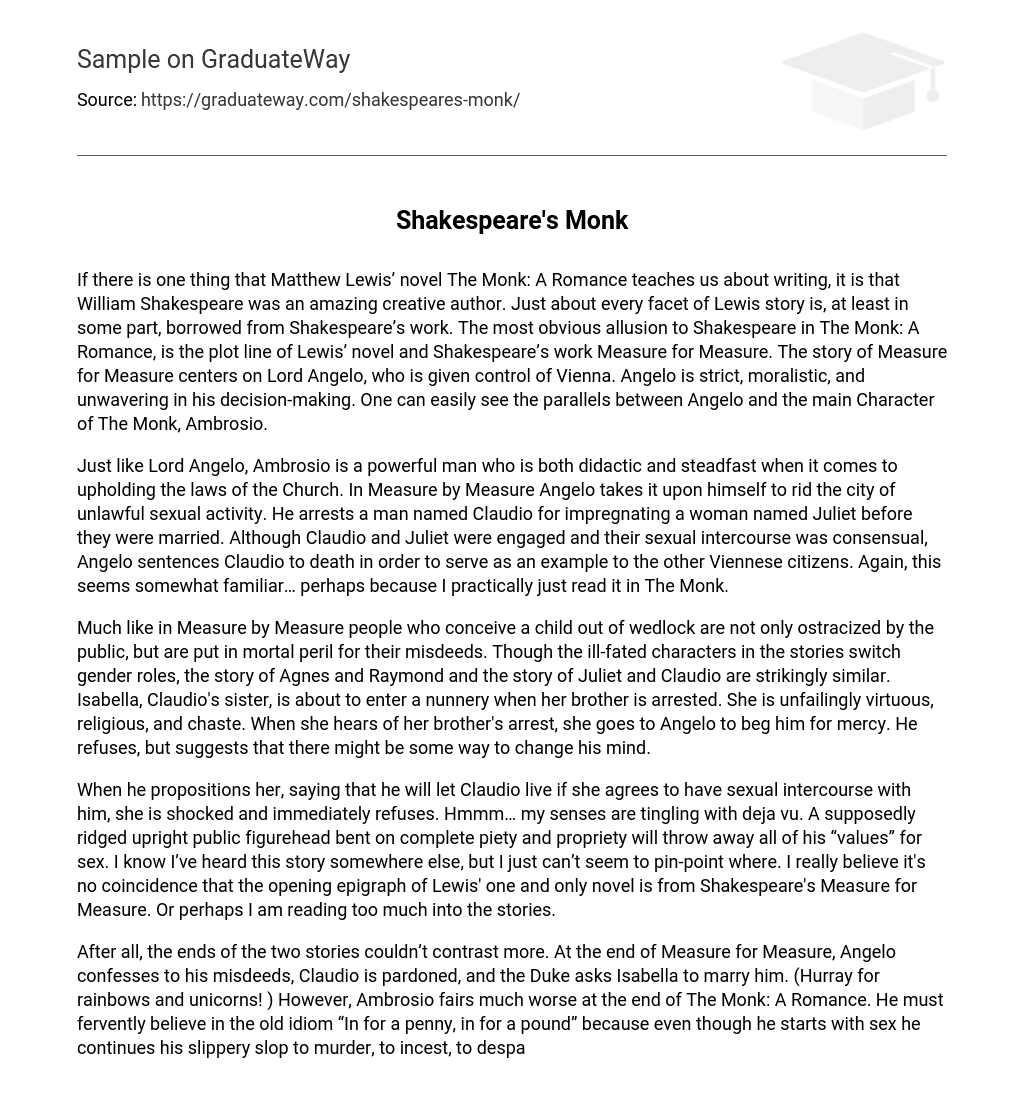The main lesson we can learn about writing from Matthew Lewis’ novel The Monk: A Romance is that William Shakespeare was a remarkable and imaginative author. Almost every aspect of Lewis’ story is inspired by Shakespeare’s works. The most evident reference to Shakespeare in The Monk: A Romance is seen in the plot, which resembles that of Measure for Measure. In Measure for Measure, the focus is on Lord Angelo, who is given authority over Vienna. Angelo is strict, moralistic, and resolute in his decision-making. The similarities between Angelo and the protagonist of The Monk, Ambrosio, are quite apparent.
Both Lord Angelo and Ambrosio are powerful men who uphold the laws of the Church in a didactic and steadfast manner. In Measure by Measure, Angelo takes on the responsibility of eliminating unlawful sexual activity in the city. He apprehends Claudio, who impregnated Juliet before their marriage, although they were engaged and had consensual intercourse. Angelo, like Ambrosio, sentences Claudio to death as a means of setting an example for the other citizens of Vienna. This storyline bears similarities to The Monk, which I recently read.
Both Measure by Measure and the stories of Agnes and Raymond, as well as Juliet and Claudio, depict individuals who bear a child outside of wedlock facing public exclusion and mortal peril for their transgressions. Despite the varying genders of these characters, similarities arise. Isabella, Claudio’s sister in Measure by Measure, intends to become a nun but feels compelled to intervene when her brother is imprisoned. She remains virtuous, devoted, and chaste. After discovering her brother’s arrest, Isabella pleads for mercy from Angelo. Although he initially refuses, he hints at the possibility of influencing his decision.
The woman is shocked and refuses when he proposes a deal, offering to spare Claudio’s life in exchange for having sex with him. It feels familiar, like I’ve seen this situation before. A supposedly strict and honest public figure, who claims to value virtue and morality, is willing to abandon all of his “principles” for sexual gratification. The opening quote in Lewis’ only novel being from Shakespeare’s Measure for Measure makes me believe it’s not a coincidence. Or maybe I’m overanalyzing these stories.
At the conclusion of both Measure for Measure and The Monk: A Romance, the outcomes for the characters couldn’t be more contrasting. In Measure for Measure, Angelo confesses his wrongdoings, Claudio receives forgiveness, and the Duke proposes marriage to Isabella (Hurray for rainbows and unicorns!). On the other hand, Ambrosio’s fate in The Monk is much bleaker. Despite starting with sex, he descends into a slippery slope of murder, incest, despair, and ultimately damnation. Additionally, Matthew Lewis incorporates elements of William Shakespeare’s Macbeth into his novel.
Although the similarities between the two stories are not as strikingly similar as The Monk and Measure for Measure, I assure you, they exist. In this case, Lewis uses Shakespeare’s works primarily for character development. The resemblances between Ambrosio and Macbeth, and Matilda and Lady Macbeth are quite obvious. Ambrosio, like Macbeth, is easily manipulated. Despite his immense power, he can be convinced by just a word from Matilda to do something that he knows is morally wrong.
Despite his initial resistance to Matilda, Ambrosio is eventually persuaded by her to kill those who oppose him. In the play Macbeth, the protagonist is labeled a “butcher” for his readiness to do anything for Lady Macbeth, even murdering innocent women and children in addition to his king and enemies. Both Ambrosio and Macbeth possess numerous violent traits, but it is the women in both narratives who take center stage. It seems that Lewis aims to encompass every aspect of Lady Macbeth’s character in his novel.
Without a doubt, Matilda embodies the wickedness and manipulative nature reminiscent of Lady Macbeth, becoming a convergence of various characters in the novel. It would be impossible to overlook the similarity between the bloodstained Lady Macbeth (after Duncan’s murder) and the Bleeding Nun from Lewis’ The Monk. (“Out damn spot!”) It is evident that Lewis greatly admired Shakespeare’s work, acting as a modern-day rap music producer who incorporates elements of previous, superior artists while adding his own original lyrics to an existing beat.
Similar to a modern-day producer, Lewis was not restricted to sampling only one artist. His work clearly showcases influences from Marlow’s Faust and Sophocles’ Oedipus Rex in the realm of drama. I don’t intend to critique Matthew Lewis. He definitely accomplished something commendable with this novel. In fact, I’ve had to read The Monk twice in my young life, even though it was published 220 years ago! (Plus, I happen to enjoy listening to some hip hop occasionally.) However, I can confidently assert that regardless of how well deserved it may be, Lewis owes a significant portion of his success to William Shakespeare.
Click here to access a website with information about Shakespeare’s monk.





